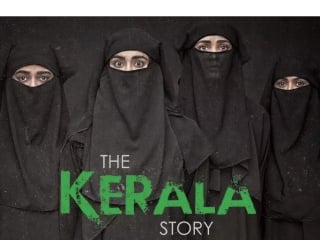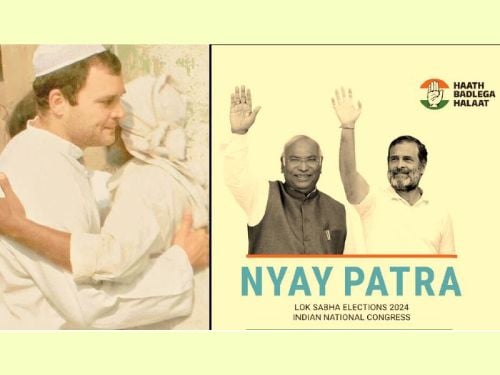 Mohammad Hamid Ansari made an ungraceful exit on Thursday (10 August) after serving for a decade as India’s Vice President and presiding over Rajya Sabha as its Chairman. He didn’t cover himself in glory when he raised, not for the first time, the bogey of ‘minorities in danger’ in an exclusive interview to Rajya Sabha TV. Despite serving two terms in one of the country’s highest Constitutional posts, Ansari couldn’t break free from his “basic ideology” Prime Minister Narendra Modi referred to in his farewell speech laden with left-handed compliments. As this Swarajya column puts it succinctly, “Ansari’s “basic ideology” can be presumed to refer to some form of minoritarian thinking.”
Mohammad Hamid Ansari made an ungraceful exit on Thursday (10 August) after serving for a decade as India’s Vice President and presiding over Rajya Sabha as its Chairman. He didn’t cover himself in glory when he raised, not for the first time, the bogey of ‘minorities in danger’ in an exclusive interview to Rajya Sabha TV. Despite serving two terms in one of the country’s highest Constitutional posts, Ansari couldn’t break free from his “basic ideology” Prime Minister Narendra Modi referred to in his farewell speech laden with left-handed compliments. As this Swarajya column puts it succinctly, “Ansari’s “basic ideology” can be presumed to refer to some form of minoritarian thinking.”
Ansari is not alone. Many public commentators and intellectuals share his worldview, and it was the guiding principle of the previous United Progressive Alliance (UPA) government. Manmohan Singh even said that minorities, particularly Muslims, must have the first claim on resources. However, now we are led to believe that since Modi became Prime Minister, minorities are under siege.
“Do Minorities Matter?”, senior journalist Shekhar Gupta asks in his latest column in The Print, a media startup he founded. He writes, “I have checked, even deep-trawled the history of many short-term governments, but failed to find another instance at least in the past 50 years when none of our top political positions: president, vice-president, prime minister, speaker of Lok Sabha and top ministries (home, finance, defence, external affairs) was held by a member of one of our minority communities.”
Gupta is right. But he is wrong to conclude that “India’s minorities have never been so out of the power structure. They are justified in having a sense of unease about it.” (emphasis mine)
Are minorities feeling uneasy because they didn’t get a seat at the high table? Such analysis is shallow, simplistic and dangerous, and has been done to death. Jats revolted because the Bharatiya Janata Party (BJP) appointed a non-Jat Chief Minister in Haryana, Marathas not happy as there aren’t enough Maratha ministers in the Maharashtra cabinet and so on. These symbolic gestures matter but rank quite low in the needs hierarchy. Why would a poor Muslim in a remote Indian village care if the country’s external affairs minister is Sushma or Salman?
Now let’s take Gupta’s logic of drawing parallels between power structure and uneasiness and apply it to the UPA government. Nominal prime minister Manmohan Singh, real prime minister Sonia Gandhi, her second-in-command Ahmed Patel, defence minister A K Antony, external affairs minister Salman Khurshid, vice president Hamid Ansari were all from the minority communities. Only two, home minister Sushil Kumar Shinde and finance minister P Chidambaram were Hindus. And can one be wrong to term the latter a ‘Hindu in Name Only’ or HINO? After all, he moved heaven and earth to create the bogey of Hindu terror at the behest of his minority masters. Gandhi and Patel picked Shinde because of his Dalit credentials and loyalty.
Did the majority community feel uneasy under a government run by all top minority ministers? If someone had even so much as hinted that, Gupta would have laughed them out of the room. But since it’s the minorities, he feels that they are justified in saying so.
Cosmetic vs real battles
The argument is bunkum that minorities must be feeling uneasy because one of them isn’t sitting on influential chairs on Raisina Hill. This was Jinnah’s worldview, of separate electorates, which was thoroughly rejected by the founders of the Indian republic. It had no place in modern India then, and it has no place now.
In any case, this is a cosmetic battle. In real power terms, minorities matter much more than the majority.
Let’s talk about our minoritarian education laws. The Right to Education Act, which mandates that schools set aside 25 per cent of the seats for students from weaker sections of society (almost free of charge), is only applicable to Hindu-run institutions. Gandhi’s UPA government exempted the minority institutions from this burden. There are minority institutions in the country which are funded by the government up to 95 per cent, yet they do not have to follow reservation guidelines for SC/ST/OBCs in hiring teachers. There are no restrictions placed on hiring non-minority faculty, and they can determine their criteria for admitting students – luxuries which aren’t available to the majority.
While the Hindu-run institutions ran for cover, minority ones boomed. This was further facilitated by the creation of a body like the National Commission for Minority Education Institutions (NCMEI), which liberally gave minority certificates to thousands of institutions. Can anyone imagine a secular country running a purely sectarian scheme like this? But in India, minorities matter.
Let’s talk about minoritarian scholarships. The central government alone runs these 12 schemes exclusively for minorities.
- Pre-matric scholarship for Class I to X: Rs 1,100 crore given to 7,500,000 minority students in 2014-15
- Post-matric scholarship for Class XI to PhD degree: Rs 501 crore given to 905,620 minority students in 2014-15
- Merit-cum-means-based scholarship scheme for professional and technical courses: Rs 381 crore disbursed to 138,770 students in 2014-15
- Free coaching and allied scheme for competitive examinations of professional courses and government jobs: a stipend of Rs 1,500 is given to local students and Rs 3,000 to outstation students respectively. Beneficiaries have doubled under the Modi government.
- Maulana Azad National Fellowship for MPhil & PhD students: Over Rs 55 crore disbursed in 2015-16
- Support for minorities for clearing prelims exam conducted by Union Public Service Commission, Staff Selection Commission and State Public Service Commission: minority students get Rs 50,000 for gazetted post and Rs 25,000 for non-gazetted post on clearing the prelims stage of these exams
- Padho Pardesh for overseas studies at the Masters, MPhil and PhD levels: interest subsidy of Rs 7.5 crore given to 1,343 students in 2015-16
- Nai Manzil: Launched by the Modi government in 2015 with an aim to help minority youth who studied in madrasas. In 2016-17, Rs 155 crore was disbursed for the training of 25,000 such youth.
- Begam Hajrat Mahal National Scholarship for meritorious girls belonging to minorities studying in Classes XI and XII: scholarship exclusive to minority girls. 48,000 girls benefited under this scheme at a cost of Rs 57 crore.
If you are born to poor parents in the majority community, too bad. These schemes are not for you. Even scholarship amounts given to students from OBC/SC community are way lower than what minority students get. Can anyone imagine a secular country running a purely sectarian scheme like this? But in India, minorities matter.
Let’s talk about minoritarian economic empowerment. The National Minorities Development and Finance Corporation is a Government of India body which gives loans to minorities. Under term loan scheme, a member of a minority community can get a loan up to Rs 30 lakh at 8 per cent interest (6 per cent for women) with a repayment period of five years. He or she can also get an education loan up to Rs 20 lakh for ‘Professional & Job Oriented Degree Courses’ in India and up to Rs 30 lakh if studying abroad! He or she can also get a loan up to Rs 30 lakh as part of micro-financing scheme at a measly 4 per cent rate (2 per cent for women). There are other provisional schemes for minorities too: Vocational Training Scheme, Marketing Assistance Scheme, Mahila Samridhi Yojana and Grant in Aid Assistance scheme. Can anyone imagine a secular country running a purely sectarian scheme like this? But in India, minorities matter.
Let’s talk about minoritarian infrastructure schemes. Multi-sectoral Development Programme (MsDP), a centrally sponsored scheme launched in 2009, is an area development initiative focusing only on those districts where concentration of minorities is 20 per cent and more. If you are born in a backward and poor district but don’t have enough minorities around you, too bad. Only those blocks which have at least 25 per cent minority population will be selected from a district. In the 12th Five-year Plan, 710 blocks in 196 districts were chosen for development. Sanctioned amount per year stands at upwards of Rs 1,000 crore. The irony is that in most of these towns and districts minorities are in the majority! Can anyone imagine a secular country running a purely sectarian scheme like this? But in India, minorities matter.
Let’s talk about “Seekho aur Kamao” (Learn & Earn), a special scheme for skill development of minorities or skill upgrading programme, USTTAD or Nai Roshni scheme for leadership development of minority women or “Hamari Dharohar”, a scheme to preserve rich heritage of minority communities or the scheme to strengthen waqf boards. Can anyone imagine a secular country running such purely sectarian schemes? But in India, minorities matter.
The majority community can’t enjoy the fruits of all these schemes. They are only for the minorities. And the scope and number of such schemes have only expanded under the Modi government. The majority community doesn’t have the right to run its schools freely. Its most important institution – temples – has been taken over by various state governments which channel temple grants to all kinds of secular activities, whereas the church funds schools and hospitals for the benefit of its flock. The judiciary never hesitates to censor Hindu rituals, practices or even festivals (Jallikattu, Dahi Handi, Kambala, Holi, Diwali, etc); however, the writ of the law never touches the minorities.
Minorities matter so much so that even strong groups from the majority, such as the Lingayats, are rushing to get the minority tag.
“Do minorities matter?” is thus not the right question to ask. It is, “Does the majority matter?”.
Postscript: Even an electoral majority of 282 seats in Lok Sabha doesn’t seem to matter given BJP’s failure to repeal India’s minoritarian laws and schemes, which the previous Congress government managed to pass despite having a minority in the Parliament. The BJP must remove all traces of sectarianism from governance and Constitution. It can’t fool people anymore by merely installing HINOs at the top.
Source : Swarajya Magazine




